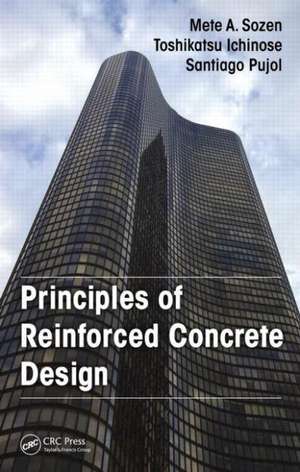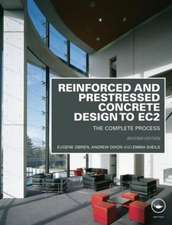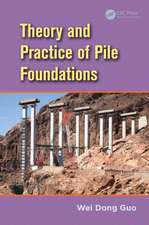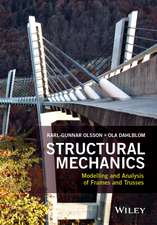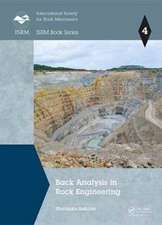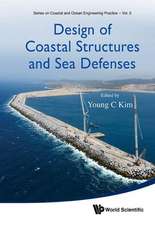Principles of Reinforced Concrete Design
Autor Mete A. Sozen, Toshikatsu Ichinose, Santiago Pujolen Limba Engleză Hardback – 14 iul 2014
The book presents design choices that fall in line with the boundaries defined by professional consensus (building codes), and provides reference material outlining the design criteria contained in building codes. It includes applications for both building and bridge structural design, and it is applicable worldwide, as it is not dependent upon any particular codes.
- Contains concise coverage that can be taught in one semester
- Underscores the fundamental principles of behavior
- Provides students with an understanding of the principles upon which codes are based
- Assists in navigating the labyrinth of ever-changing codes
- Fosters an inherent understanding of design
Principles of Reinforced Concrete Design provides undergraduate students with the fundamentals of mechanics and direct observation, as well as the concepts required to design reinforced concrete (RC) structures, and applies to both building and bridge structural design.
Preț: 767.07 lei
Preț vechi: 1104.44 lei
-31% Nou
Puncte Express: 1151
Preț estimativ în valută:
146.77€ • 153.66$ • 121.45£
146.77€ • 153.66$ • 121.45£
Carte tipărită la comandă
Livrare economică 05-19 aprilie
Preluare comenzi: 021 569.72.76
Specificații
ISBN-13: 9781482231489
ISBN-10: 1482231484
Pagini: 295
Ilustrații: 224 black & white illustrations, 4 black & white tables
Dimensiuni: 156 x 234 x 23 mm
Greutate: 0.61 kg
Ediția:1
Editura: CRC Press
Colecția CRC Press
ISBN-10: 1482231484
Pagini: 295
Ilustrații: 224 black & white illustrations, 4 black & white tables
Dimensiuni: 156 x 234 x 23 mm
Greutate: 0.61 kg
Ediția:1
Editura: CRC Press
Colecția CRC Press
Cuprins
A Brief History of Reinforced Concrete. Structural Framing in Reinforced Concrete. The Design Process. Properties of Steel Reinforcement. Concrete. Time-Dependent Volume Changes of Concrete: Shrinkage and Creep. Tied Columns. Axial Strength of Laterally Confined Concrete. Spiral Columns. Measures of Flexural Response. A General Description of Flexural Response. Moment-Curvature Relationship before Flexural Cracking. Linear Response of Cracked Sections. Limiting Moment and Unit Curvature. Development of a Quantitative Relationship between Moment and Unit Curvature. Maximum and Minimum Amounts of Longitudinal Reinforcement for Beams. Beams with Compression Reinforcement. Beams with Flanges. Deflection under Short-Time Loading. Effects of Time-Dependent Variables on Deflection. Continuous Beam. Limiting Load. Combinations of Limiting Axial Force and Bending Moment for a Reinforced Concrete Section. Bond Properties of Plain Bars in Concrete. Bond between Deformed Bars and Concrete. Factors That Affect Bond. Design Examples for Bond. Control of Flexural Cracks. Combined Bending and Shear. Transverse Reinforcement. Index.
Recenzii
"The material is presented in a basic and intuitive manner. The book emphasizes basic concepts and gets those concepts across in a manner a novice structural engineer can grasp. The book does not lose sight of big-picture design decisions and does not get bogged down with prescriptive code clauses."
—Wassim Ghannoum, University of Texas at Austin, USA
"…presents a terrific overview of fundamental techniques in reinforced concrete design. Unique to this textbook is the author’s detailed introduction of the history and evolution of reinforced concrete. By showing students how the technical challenges of the day called for particular improvements in reinforced concrete design techniques, the authors will surely motivate students to pursue the research necessary to create their own innovations in the field."
––Dr. Mohammed E. Haque, PE, Texas A&M University, College Station
"The book provides perspective to an undergraduate student that is trying to understand how concrete structures stand up. It does not throw the novice student into the intricacies of the Code, but instead builds on first principles that the student learned in earlier classes and provides a guide for how design of concrete structures fit with that theory."
—JoAnn Browning, University of Kansas
"The book material is prepared in a way that lends itself perfectly for the first undergraduate class in reinforced concrete design. The division of material into small sections that can be read easily and discussed in class sessions provides a fresh look to the traditional way textbooks related to reinforced concrete design are written. The chapter on history of reinforced concrete (Chapter 1), in particular, contains a wealth of information on specific developments that have led to the current practice of reinforced concrete construction and design. Almost each sentence in this chapter mentions a major development that the reader may be interested in studying in more detail."
—Sergio F. Breña, University of Massachusetts Amherst
—Wassim Ghannoum, University of Texas at Austin, USA
"…presents a terrific overview of fundamental techniques in reinforced concrete design. Unique to this textbook is the author’s detailed introduction of the history and evolution of reinforced concrete. By showing students how the technical challenges of the day called for particular improvements in reinforced concrete design techniques, the authors will surely motivate students to pursue the research necessary to create their own innovations in the field."
––Dr. Mohammed E. Haque, PE, Texas A&M University, College Station
"The book provides perspective to an undergraduate student that is trying to understand how concrete structures stand up. It does not throw the novice student into the intricacies of the Code, but instead builds on first principles that the student learned in earlier classes and provides a guide for how design of concrete structures fit with that theory."
—JoAnn Browning, University of Kansas
"The book material is prepared in a way that lends itself perfectly for the first undergraduate class in reinforced concrete design. The division of material into small sections that can be read easily and discussed in class sessions provides a fresh look to the traditional way textbooks related to reinforced concrete design are written. The chapter on history of reinforced concrete (Chapter 1), in particular, contains a wealth of information on specific developments that have led to the current practice of reinforced concrete construction and design. Almost each sentence in this chapter mentions a major development that the reader may be interested in studying in more detail."
—Sergio F. Breña, University of Massachusetts Amherst
Notă biografică
Mete A. Sozen, S.E. (IL), a graduate of Bogazici University (Istanbul) and the University of Illinois at Urbana–Champaign, is the Kettelhut Professor in the Department of Civil Engineering at Purdue University, West Lafayette, Indiana. He teaches courses on reinforced concrete and earthquake-resistant design. He is a member of the U.S. National Academy of Engineering and the Royal Swedish Academy of Engineering Sciences. He is an honorary member of the Turkish Society for Engineers and Scientists, the American Society of Civil Engineers, the American Concrete Institute, the Architectural Institute of Japan, and the International Association for Earthquake Engineering. Dr. Sozen has been granted honorary degrees by Bogazici University (Turkey), Janus Pannonius University (Hungary), and the Tbilisi Technical University (Georgia). He was included in the Applied Technology Council and the Engineering News-Record lists of the top ten seismic engineers of the 20th century. Dr. Sozen has worked as a consultant with the Veterans Administration, the Department of State, Bechtel, Brookhaven National Laboratory, Consumers Power Co., Electric Power Research Institute, ERICO, Lawrence Livermore Laboratories, Los Alamos National Laboratory, Nuclear Regulatory Commission, SANDIA National Laboratories, U.S. Army Engineering R & D Center in Vicksburg, WJE Engineers, and Westinghouse Savannah River Site. He has worked on design and evaluation of concrete dams with the U.S. Bureau of Reclamation, Pacific Gas and Electric Co., and Southern California Edison.Toshikatsu Ichinose completed his undergraduate education in architectural engineering at Nagoya Institute of Technology and earned graduate degrees at the University of Tokyo. In 1982, he returned to Nagoya Institute of Technology, where he now teaches structural mechanics and reinforced concrete. Dr. Ichinose has been chairing the committee in charge of RC building code of the Architectural Institute of Japan since 2004. He is proud to be a coauthor of Understanding Structures (CRC Press, 2008).
Santiago Pujol is from Medellín, Colombia, where he was first exposed to the reinforced concrete industry by his father, an architect who designed and directed the construction of a number of residential and commercial buildings in the city. He completed his undergraduate education in civil engineering at the School of Mines at the National University of Colombia in 1996. At the time, the School of Mines had a five-year undergraduate program designed after European academic models. Damage caused by earthquakes in Colombia motivated him to earn an MS and PhD from Purdue University, West Lafayette, Indiana. Dr. Pujol worked with a forensic firm in San Francisco, California, from 2002 to 2005. During that time, he traveled to Japan and started lasting collaborations with Japanese engineers whose wisdom and attention to proportions and aesthetics have a strong influence on his views. In 2005, he returned to Purdue University, where he currently teaches reinforced concrete and experimental methods and conducts research dealing with the effects of blasts and earthquakes on buildings, and basic questions on the mechanics of concrete structures.
Santiago Pujol is from Medellín, Colombia, where he was first exposed to the reinforced concrete industry by his father, an architect who designed and directed the construction of a number of residential and commercial buildings in the city. He completed his undergraduate education in civil engineering at the School of Mines at the National University of Colombia in 1996. At the time, the School of Mines had a five-year undergraduate program designed after European academic models. Damage caused by earthquakes in Colombia motivated him to earn an MS and PhD from Purdue University, West Lafayette, Indiana. Dr. Pujol worked with a forensic firm in San Francisco, California, from 2002 to 2005. During that time, he traveled to Japan and started lasting collaborations with Japanese engineers whose wisdom and attention to proportions and aesthetics have a strong influence on his views. In 2005, he returned to Purdue University, where he currently teaches reinforced concrete and experimental methods and conducts research dealing with the effects of blasts and earthquakes on buildings, and basic questions on the mechanics of concrete structures.
Descriere
The book covers fundamental concepts related to mechanics and direct observation, and those required to design reinforced concrete (RC) structures. Codes change over time depending on factors that have little to do with the fundamental concepts mentioned, and have more to do with the markets, construction practices, and transient academic views. For beginning engineers it is difficult to distinguish between rules based on consensus (codes) and fundamentals. This book focuses on the latter to prepare use and adaptation to the constant changes of the former.
